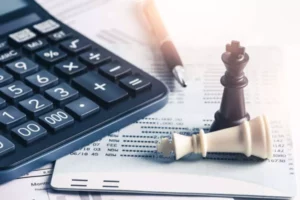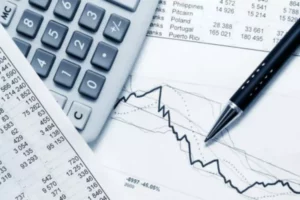Step-by-Step: How To Make a Balance Sheet Chase for Business
7 de outubro de 2020Journal entry testing using Excel
2 de dezembro de 2020Content

Another financial statement that is used in business to measure the financial health of the business is the statement of cash flow. The statement of cash flow, or the cash flow statement, is a financial statement that shows how the cash flows in and out of a business within a given time period. The purpose of preparing is to understand where the money is flowing within an organization and how it is spent.
- For example, consider a person who invests $10,000 in a company’s stock, then sells that stock for $12,000.
- In addition, certain items from the Treasury’s balance sheet that affect the supply of reserve balances are included.
- The concept of “present value” (PV) describes calculated adjustments that express those future funds in present-day dollars.
- Also, accelerated depreciation can be used to artificially reduce the reported amount of fixed assets, so that the fixed asset investment appears to be lower than is really the case.
- Examples include rent, employee compensation, and property taxes.
- There are many more assets and liabilities that could be included depending on the type of business.
Single-entry systems account exclusively for revenues and expenses. Double-entry systems add assets, liabilities, and equity to the organization’s financial tracking. When balance sheet is prepared, the current assets are listed first and non-current assets are listed later. The balance sheet tells us what a company’s financial position is on a given date. In fact, many call it a ‘snapshot’ of the firm’s financial position at a point in time.
The Purpose of the Balance Sheet
The balance sheet summarizes the financial position of a company at a specific point in time. Shareholder’s equity also includes retained earnings ― the portion of the net income that hasn’t been distributed to shareholders as dividends ― to be used for funding further growth and expansion of the business. Large businesses will have longer and more complex balance sheets for their businesses, sometimes having separate balance sheets for different segments or departments of their business. A small business balance sheet will be more straightforward and have fewer line items. This doesn’t apply to all legal structures for a business; if you are a pass-through tax entity, then all profits or losses will be passed on to owners, and your balance sheet should reflect that.
- By this approach, still other investors would not need to take any losses unless these mortgage-backed financial securities lost 25% or 30% or more of their total value.
- Small corporations—those with total receipts and total assets less than $250,000 at the end of the year—are not required to complete the balance sheet in the tax return.
- To a skilled analyst, the data presented in a profit and loss statement can provide deep insights with the use of ratios.
- More precisely, divide total liabilities by total assets to obtain a percentage.
- Balance sheets are prepared as of a specific point in time (e.g., month-end, quarter-end, year-end).
- Preferred stock is assigned an arbitrary par value (as is common stock, in some cases) that has no bearing on the market value of the shares.
Current liabilities are due within one year and are listed in order of their due date. Long-term liabilities, on the other hand, are due at any point after one year. Accounts within this segment are listed from top to bottom in order of their liquidity.
Equity / capital
Accept debit and credit cards with safe, secure, and convenient Payment Solutions from Chase anywhere you do business – online, in-store, and on-the-go. Visit our Developer Center to find Payments APIs, developer tools, and documentation. Find and apply for the Ink business credit card best suited for your business. Here are four ways you can use a balance sheet for your business.

Inventory includes amounts for raw materials, work-in-progress goods, and finished goods. The company uses this account when it reports sales of goods, generally under cost of goods sold in the income statement. As such, the balance sheet is divided into two sides (or sections). balance sheet basics The left side of the balance sheet outlines all of a company’s assets. On the right side, the balance sheet outlines the company’s liabilities and shareholders’ equity. In this example, Apple’s total assets of $323.8 billion is segregated towards the top of the report.
Get familiar with your balance sheet
Overhead (O/H) costs describe expenses necessary to sustain business operations that do not directly contribute to a company’s products or services. Examples include rent, marketing and advertising costs, insurance, and administrative costs. Accountants track partial payments on debts and liabilities using the term “on credit” (or “on account”).
The larger the percentage (the debt ratio), the more the company is leveraged. This could present problems when a company is too heavily leveraged. A bank uses the information in a balance sheet to determine whether to lend a loan applicant money. The bank might also use it to decide whether to lend a borrower more money. Using a balance sheet template will streamline the next step of the process, so that you don’t have to manually insert all of the fields yourself. This is a vital step towards understanding the core strength of a company, and to assess the business performance.
Know your business’s finances to succeed
Accountants prepare or generate trial balances at the conclusion of a reporting period to ensure all accounts and balances add up properly. In professional practice, trial balances function like test-runs for an official balance sheet. In accounting, liquidity describes the relative ease with which an asset can be sold for cash. Assets that can easily be converted into cash are known as liquid assets. Accounts receivable, securities, and money market instruments are all common examples of liquid assets. A liability (LIAB) occurs when an individual or business owes money to another person or organization.
There are several issues with the balance sheet that one should be aware of. One concern is that some of the information presented in this report is stated at its historical cost (such as fixed assets), while other information is presented at its current cost (such as marketable securities). A second issue is that some information in the report is subject to manipulation. For example, the amount of accounts receivable will depend on the offsetting balance in the allowance for doubtful accounts, which contains a guesstimated balance. Also, accelerated depreciation can be used to artificially reduce the reported amount of fixed assets, so that the fixed asset investment appears to be lower than is really the case.
What Is Included in the Balance Sheet?
It is expressed as the number of times current assets exceeds current liabilities. Perhaps the most useful aspect of your balance sheet is its ability to alert you to upcoming cash shortages. After a highly profitable month or quarter, for example, business owners sometimes get lulled into a sense of financial complacency if they don’t consider the impact of upcoming expenses on their cash flow. Overall, the balance sheet gives you insights into the health of your business. It’s a snapshot of what you have (assets) and what you owe (liabilities). Keeping tabs on these numbers will help you understand your financial position and if you have enough cash to make further investments in your business.
